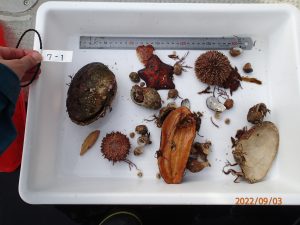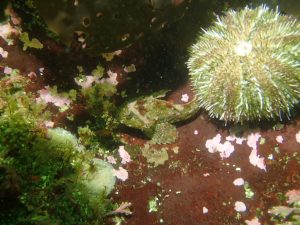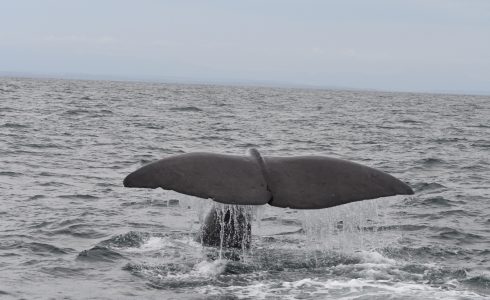D2のJさんから,9月に行われたラッコ調査の報告です!
ーーーーーーーーーーーーーーーーーーーー
The research team arrived to Kushiro, September 1st 2022. The following day we departed for the Akkeshi Marine Station, where we would be staying for the majority of our research period.
Akkeshi is a small town of just under 9,000 people, found in the far east of Hokkaido. It is located in between Akkeshi bay and Akkeshi lake, making it a unique geographic landmark. Originally a penal colony, historically the majority of Akkeshi’s economy has run through fisheries and maricultural harvesting industries. Akkeshi was an ideal location to be based out of, as it was close to our field study site.

Cormorants along rocks
The field study location consisted of small atoll islands, and were ideal nesting locations for a variety of sea bird species.

Rhinoceros Auklet (Cerorhinca monocerata)

White-tailed fishing eagle (Haliaeetus albicilla)
They were also home to a fluctuating number of White-tailed fishing eagles, who served as the apex avian predators.

Harbor seal (Phoca vitulina)
It was also possible to see both sea otters and seals amongst the islands.

Sea otter (Enhydra lutris) with pup

The ocean conditions could be quite variable, and range from calm and negligible swells, too much choppier seas. However, during this September survey period, we had unseasonably warm and clear weather, which allowed us to embark on the water for 10 of the 14 potential survey day periods. For perspective, during May and June, we were only able to get out on the water for research for 10 out of 30 potential survey days.

Sea otters amongst the sugamo (sea grasses)
Sea Otters were historically present in Hokkaido to some extent, but were extirpated over 150 years ago. However, thanks to international protections, many of which were initially provided from the 1911 fur seal treaty, the populations slowly and steadily began to recover from the 1980s onwards. The goal of this research period was to gain further insight into the Hokkaido sea otter (Enhydra lutris) population, and their distribution and dietary habits. One area of interest was to see how a recent extreme environmental event had impacted the benthic organism community as well as the sea otters of the region. During October of 2021, there was a massive harmful algal bloom, or red tide of Karenia selliformis dinoflagellates, which resulted in a massive die-off of several marine species, including sea urchins.

During the year of 2022, we had already journeyed to East Hokkaido to collect data twice, during May/ June and during July. The standard techniques utilized on all three research trips involved focal observations of sea otter behavior, visual feeding dive observations, basic survey records of otter GPS location, and drone photography of the marine plant habitat at the study site.

Though the assistance of a local boat captain, we were able to charter a small boat where we would embark from the nearest town dock. We commissioned a professional diver to collect benthic organisms from designated stations around the survey site. The purpose of this section of the research was to gain insight into the overall benthic organism community. For this year, it would aid in estimating the impact of the red tide event on the ecosystem.

Benthic Organisms

The Observation Team Members: Dr. Yoko Mitani, Prof. Ippei Suzuki, Doctoral Student Jackson Johnstone, Masters Student Natsuki Konno, Masters Student Kyohei Murayama, Undergraduate Student Asuka Yushima









